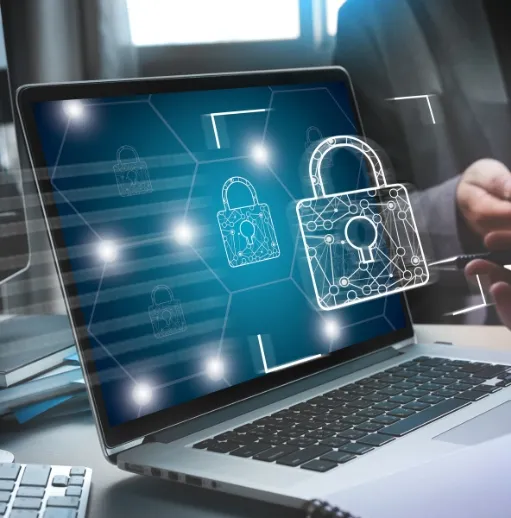
As your organization embraces remote and hybrid work models, data security becomes more important. In the past, companies benefited from having nearly everyone in the same office, connected to the same systems, making security easier because everything was focused on single locations.
But as the workforce spreads out, vulnerabilities may increase. For example, it’s harder to protect sensitive information on personal laptops and in homes or coffee shops where employees may be working on public Wi-Fi, despite company policies. So, as you evaluate new workplace technology, you need to work closely with your information technology (IT) department to ensure it has the right security features.
Regulations governing workplace technology
In an interconnected world, requirements from far away can have local implications. The Internet has connected the world so intricately that we can hire employees — and provide services to — from just about any country in the world, so make sure you’re in compliance with international regulations governing privacy and security.
General Data Protection Regulations (GDPR)
While you’re probably aware of European Union (EU) security and data privacy laws, you may not have considered how they impact your workplace technology. If you are using applications that collect employee data (such as wearable devices), you need to notify employees about what information you plan to collect, how you will use it, and how you will keep any personal information secure. Even if you aren’t doing business in the EU, this is essential for building a relationship based on mutual trust.
Your IT team might also have to evaluate third-party data processors, including cloud providers, and ensure they comply with GDPR.
California Consumer Protection Act (CCPA)
Under the California Consumer Protection Act, businesses must disclose any personal information they collect and share. Consumers also have a right to ask businesses to delete their personal information or forbid them from selling it.
While this likely won’t impact employee applications, you may need to re-evaluate the type of information you collect from customers and ensure you are properly disclosing it.
SOC compliance
SOC compliance shows your organization’s information security is high. SOC1 compliance is for companies that hold financial information and SOC2 is for all other companies.
If your company is a service organization, you’ll probably have to pass a SOC2 audit to be able to provide services to other companies. What does that include?
The five principles of SOC2 compliance are:
- Common criteria/security
- Availability
- Processing integrity
- Confidentiality
- Privacy controls
Are your systems and information protected? Are they accessible and able to be used for operations? Is your company protecting confidential information? Is your company collecting, using, disclosing, and discarding personal information in a way that aligns with your company’s objectives?
It’s important that your third-party vendors follow these guidelines as well and not just your internal staff.
Choosing SOC2 compliant workplace technology is a proactive step your company can take to ensure you’re protecting customer and employee data.
Security features for workplace technology
In addition to compliance, you can look at security through the lens of specific features.
Access control management
Demanding proof that users are who they claim to be and have been authorized to access certain information is a must, regardless of the size of your company.
A good general rule is to give employees and vendors access only to the data needed for their jobs. You want to leverage the software to empower people, but only ever up to a specific point.
Two-factor authentication
In a cloud-based environment, identity is everything. Unfortunately, hackers have become more sophisticated, and mobile applications without proper protections can leave organizations more vulnerable to breaches.
Two-factor and multi-factor authentications are forms of access control that require additional information to access an account. After logging in successfully, you may have to enter a code that is sent to your cell phone within a certain timeframe.
A mobile-centric zero-trust approach
The concept of “zero trust” is based on the idea that organizations should always verify before granting access. A mobile zero-trust approach takes password protection and two-factor authentication a step further by establishing a framework that includes:
- Ensuring every user has a device with the right apps and permissions
- Verifying access, not only by verifying the user but also checking the network type
- Enforcing strict security policies
- Protecting workplace technology from viruses, malware, and any other potential threats
Ensuring your workplace technology is up to date is only the first step to zero-trust security. Look for software and applications that deploy updates automatically, rather than relying on employees to continually make updates.
You may also need to work with your IT team to update policies for network access. That includes ensuring all employees use secure Wi-Fi while working remotely.
Data encryption at rest
The opposite of data in transit, data at rest is just what it sounds like. Rather than being transferred across networks or from a device to storage, data at rest is sitting in storage.
Encrypted data is data locked in a virtual safe that requires a key for entry, so even if a hacker breaks into the vault, the goods will be useless to them without the decryption key.
We tend to focus on encryption efforts for data in motion: When we enter data and hit send, will someone intercept it along the way? But protecting data at rest is just as important.
Cloud-based software
Cloud-based networks are easy to access and use for storage, making them great tools for teams that aren’t all in the same building.
Since you don’t have to have your own servers, cloud networks allow small operations to have large amounts of storage space that is easily scalable depending on current needs.
Your data is also more secure because servers won’t be damaged by natural disasters, fires, or someone physically tampering with them.
If using a cloud-based network, review the provider’s privacy policies and security measures. To keep your company’s data secure, make sure remote workers are using a portable Wi-Fi hotspot rather than public Wi-Fi.
Security and the “human factor”
People are often the weak link when it comes to security. Look at your vendor management policies. What platforms and data can your third-party vendors access? When you give them access to additional information or platforms, be sure to change the protocols as needed.
Know who’s accessing confidential information through company laptops versus personal laptops, including third-party vendors and contract employees or freelancers.
Additionally, make sure employees outside of the IT department understand what constitutes high-risk behavior, such as weak passwords and sharing logins and passwords among multiple users. Don’t assume it’s “common sense.” For example, you might think everyone already knows how the classic gift card scam works, but how can you explain why lots of people still manage to fall victim to it?
In the end, organizations need to increase flexibility and accessibility while also maintaining security. It’s a process that requires support from the whole team and across departments. By ensuring compliance with regulations and standards and focusing on security features that protect your data, you can support new work models while still staying safe.




